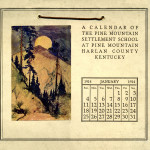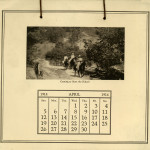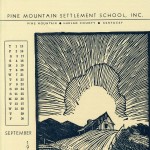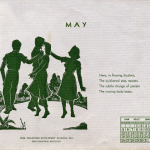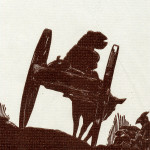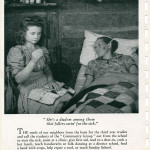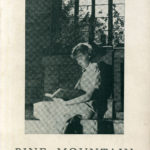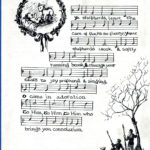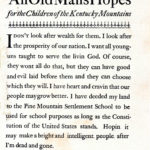Pine Mountain Settlement School
Series 17: PUBLICATIONS PMSS
Calendars Guide
1914, 1938-1978
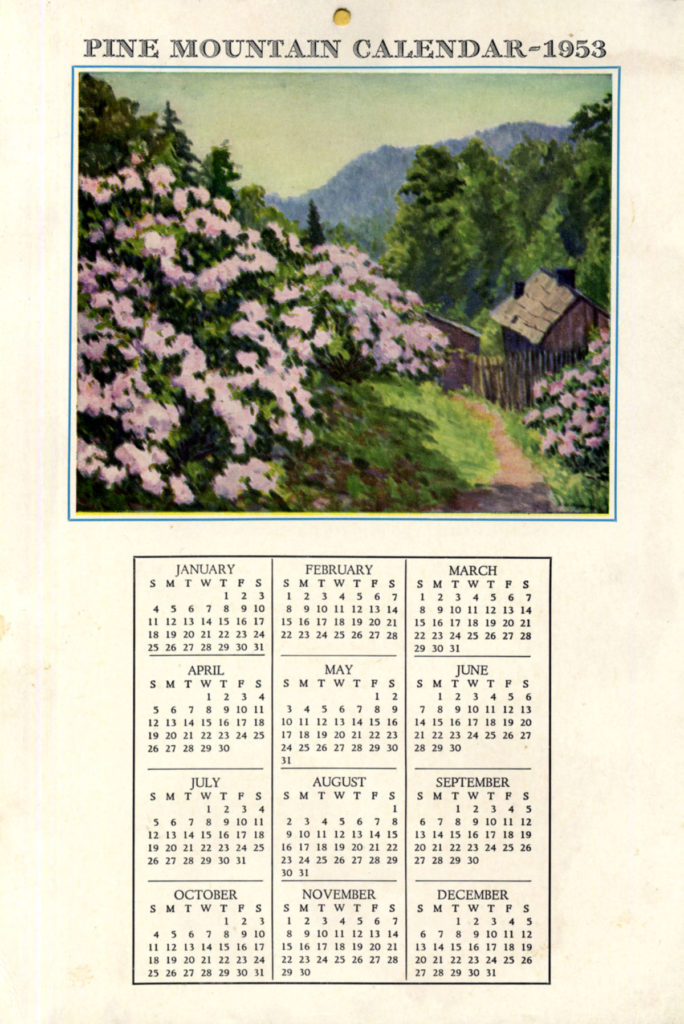
[1953_calendar_001.jpg]
TAGS: publications by PMSS, guide to PMSS calendars, fundraising, reflections on the meaning of “time,” links to pages with images of calendars, print shop, John Spelman III, Arthur W. Dodd photographs, Mary Rogers sketches, linoleum block printing, special calendars
PUBLICATIONS PMSS Calendars Guide
Among the many publications of Pine Mountain Settlement School is an array of calendars. The first calendar, published in 1914, was used as part of the fundraising campaign of the institution. The idea was a simple one that bound the promise of the new school to a future measured by the march of time.
It is not surprising that the sensitive Ethel de Long Zande, co-director of the new settlement school would settle on this instrument of months and weeks and days to measure the School’s progress through time and to aim for its future.
The writer Jorge Luis Borges spoke to the compelling nature of time when in 1946 he commented in his essay A New Refutation of Time (1946, revised 1947)
Time is the substance I am made of. Time is a river which sweeps me along, but I am the river; it is a tiger which destroys me, but I am the tiger; it is a fire which consumes me, but I am the fire.
Today time is ever more compelling as new science digs deeply into time and asks us all to reflect on “what makes it tick?” Carlo Rovelli’s The Order of Time (2017) and James Gleick’s Time Travel (2016) are two more writings among the many that have taken on the challenge of exploring that most elusive and pervasive element of our existence … time.
In their singularity, so to speak, calendars provide a thread that weaves together that elusive time. Calendars are knots in the thread that tie us to past and present. They measure our distance from the past as they measure our journey to our future. The writer Ursula Le Guin made note of the passage of time in this stanza from her short poem Hymn to Time, written just prior to her death in 2018:
Time makes room
for going and coming home
and in time’s womb
begins all ending.
In some ways, calendars are mind traps. They capture the arrows of time from year to year that mark our experiences. But, as James Gleick tells us, those experiences are only in our minds. It is the mind that does the experiencing and it is in the mind that
…we experience most immediately [and our mind] … is subject to the arrow of time. It creates memories as it goes. It models the world and continually compares these models with their predecessors. Whatever consciousness will turn out to be, it is not a moving flashlight illuminating successive slices of the four-dimensional space-time continuum. It is a dynamical system, occurring in time, evolving in time, able to absorb bits of information from the past and process them, and able as well to create anticipation for the future.
Taken as a whole the calendars of Pine Mountain create memories of place and imaginations of futures. The calendars are arrows to past, and to future. And, most importantly, calendars capture in the now, a range of personal viewpoints as each calendar creator and viewer aims their own “arrow of time.”
The Tracking of the Seasons of Time
JULIAN CALENDAR
Tracking time can be found as early as the Neolithic period of history. The first known calendars were based on the cycles of the moon. Later, primary Western calendars were based on the relationship of the earth to the sun. The Julian Calendar, named for Julius Caesar, was initiated in 46 BC and shifted away from the former lunar calendar. The Julian calendar soon became the standard adopted by western civilization and those under control of the Romans. It persisted largely because it was adopted by the later Christian church. The Julian calendar sought to simplify the complicated but accurate lunar calendar by adjustments using leap years. But, even the Julian calendar did not persist.
GREGORIAN CALENDAR
The Julian Calendar continued to perplex the timekeepers and was replaced by the Gregorian Calendar in 1582. The Gregorian calendar was named Pope Gregory XIII and was intended to refine the earlier calendar by reducing the number of leap years. The change did not happen overnight. It took some 300 years to make the adjustments. Essentially, the new calendar, like the Julian calendar, is a solar calendar with 12 months of 28–31 days each. Both calendars consists of 365 days, with a leap day being added to February in the leap years. The months and length of months in the Gregorian calendar are the same as for the Julian calendar.
While both the Julian and the Gregorian calendars based their calendars on the movement of the earth in relation to the sun, not on the cycles of the moon, they both needed continual readjustment. Ultimately, it is the Gregorian Calendar that is in use today even though it was subsequently found that the earlier calendars, based on the lunar cycle, were only two seconds off rather than our less accurate sun calendar. Further, because it continually needed to be tweaked, the day count of the 12-month calendar was affected. Atomic clocks and other time-keepers have kept us “on time.” But, time still persists in “getting away from us” as in the slowing/speeding up of the earth’s rotation.,
In Appalachia, the more tangible time-keeper, the Farmer’s Almanac ,is often used to help farmers determine when to plant and when to harvest. “Planting by the moon” is still a common practice in many households.
About the PMSS Calendars
Calendars at Pine Mountain Settlement School were not always published annually, yet there remains a remarkable number of calendars produced by the School and by individual workers. The following array of calendars covers a period from 1914 to the 1970s.
During the 1940s the publication of calendars was fairly regular. The work to produce the calendars was undertaken by students working in the print shop. It is this group of calendars that, arguably, provides the most interesting examples of this genre. These calendars were designed largely by two creative workers at the School: John Spelman III and Arthur W. Dodd,
The art for most of the late 1930s and 1940s calendars was created by John Spelman III who was employed during that time as the art teacher at the School. Spelman’s work reflects his deep affection for the Southern Appalachians and for the architectural forms of the mountain cabin in and around eastern Kentucky. He provided an outstanding model for the students and helped them to consider their own aesthetic responses to the region and the remarkable charm of the mountain log cabin and the basic principles of design in a two-dimensional format.
The second set of calendars during the 1940s, capturing the region in photographs, is the work of Arthur W. Dodd, school principal at the School and a skilled photographer. His work is found throughout the collections of Pine Mountain Settlement School’s photographs.
GUIDE I: PMSS Calendars
1914, 1938-1978
1952 PMSS CALENDAR – “A Year of Song”
GUIDE II: PMSS Calendars
1914, 1938-1978
| 1913 CALENDAR | 1978 CALENDAR | 2006 CALENDAR | |
| 1914 CALENDAR | 1951 CALENDAR | 1979 CALENDAR | 2007 CALENDAR |
| 1915 CALENDAR | 1952 CALENDAR “A Year of Song” | 1980 CALENDAR | 2008 CALENDAR |
| 1916 CALENDAR | 1953 CALENDAR | 1981 CALENDAR | 2009 CALENDAR |
| 1917 CALENDAR | 1954 CALENDAR | 1981 CALENDAR | 2010 CALENDAR |
| 1918 CALENDAR | 1955 CALENDAR | 1983 CALENDAR | 2011 CALENDAR |
| 1919 CALENDAR | 1956 CALENDAR | 1984 CALENDAR | 2012 CALENDAR |
| 1920 CALENDAR | 1957 CALENDAR | 1985 CALENDAR | 2013 CALENDAR |
| 1921 CALENDAR | 1958 CALENDAR | 1986 CALENDAR | 2014 CALENDAR |
| 1922 CALENDAR | 1959 CALENDAR | 1987 CALENDAR | 2015 CALENDAR |
| 1923 CALENDAR | 1960 CALENDAR | 1988 CALENDAR | 2016 CALENDAR |
| 1924 CALENDAR | 1961 CALENDAR | 1989 CALENDAR | 2017 CALENDAR |
| 1925 CALENDAR | 1962 CALENDAR | 1990 CALENDAR | 2018 CALENDAR |
| 1926 CALENDAR | 1963 CALENDAR | 1991 CALENDAR | 2019 CALENDAR |
| 1927 CALENDAR | 1964 CALENDAR | 1992 CALENDAR | 2020 CALENDAR |
| 1928 CALENDAR | 1965 CALENDAR | 1993 CALENDAR | 2021 CALENDAR |
| 1929 CALENDAR | 1966 CALENDAR | 1994 CALENDAR | 2022 CALENDAR |
| 1930 CALENDAR | 1967 CALENDAR | 1995 CALENDAR | 2023 CALENDAR |
| 1931 CALENDAR | 1968 CALENDAR | 1996 CALENDAR | 2024 CALENDAR |
| 1932 CALENDAR | 1969 CALENDAR | 1997 CALENDAR | 2025 CALENDAR |
| 1933 CALENDAR | 1970 CALENDAR | 1998 CALENDAR | |
| 1934 CALENDAR | 1971 CALENDAR | 1999 CALENDAR | |
| 1935 CALENDAR | 1972 CALENDAR | 2000 CALENDAR | |
| 1936 CALENDAR | 1973 CALENDAR | 2001 CALENDAR | |
| 1937 CALENDAR | 1974 CALENDAR | 2002 CALENDAR | |
| 1938 CALENDAR | 1975 CALENDAR | 2003 CALENDAR | |
| 1939 CALENDAR | 1976 CALENDAR | 2004 CALENDAR | |
| 1940 CALENDAR | 1977 CALENDAR | 2005 CALENDAR | |
| 1941 CALENDAR | |||
| 1942 CALENDAR | |||
| 1943 CALENDAR | |||
| 1944 CALENDAR | |||
| 1945 CALENDAR | |||
| 1946 CALENDAR | |||
| 1947 CALENDAR | |||
| 1948 CALENDAR | |||
| 1949 CALENDAR |
GALLERY: CALENDAR ART (A Sampling)
- [Cover] 1914 Calendar. January
- “Coming to Start the School.” 1914 Calendar. April
- 1938 Calendar. September
- 1940_calendar_005_mod
- 1940 Calendar. Linoleum prints by John Spelman III. September
- 1940 Calendar. Linoleum prints by John Spelman III. October
- 1941 Calendar. Drawing by John A. Spelman III. July
- 1942_calendar_007
- 1943 Calendar. 08
- Mattie Ayers in Chapel. [1944_calendar_001]
- 1945 Calendar Cover. [cale_1945_001.jpg]
- 1955 Calendar pmss_christensen_card_001
- 1951_calendar_000
- 1952_calendar_001
- 1956 Calendar. Drawings by Mary Rogers. [1956_calendar__001.jpg]
- 1956 Calendar Drawing by Mary Rogers. [pmss_rogers_card2_001.jpg]
- 1957_calendar_001
- [1958_calendar_001.jpg]
- An Old Man’s Hopes, William Creech. 1959_calendar_001
- 1960_calendar_001
- 1961_calendar_001
- 1969_calendar_001
- 1971_calendar_001a
- 1972_calendar_001
- 1977_calendar_001

